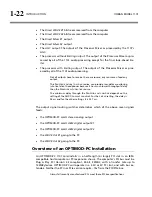
1-36
INTRODUCTION
ORBAN MODEL 1101
oscillator. In addition, OPTIMOD-PC’s output is equipped with a sample rate con-
verter that can output at 32 kHz, 44.1 kHz, 48, 88.2, or 96 kHz. These rates can be
synchronized to either AES3 digital input or to the sync input (see page 1-29).
We expect that transmitters that transmit sample rates below 32 kHz will provide
internal sample rate conversion, and that most will probably accept audio at 48 kHz
sample rate regardless of the final sample rate of the transmission.
Subframe Delay
OPTIMOD-PC provides an adjustable time delay of up to 60 milliseconds. This allows
the installer to force the total delay through the processing to equal one frame
(which is useful in sound-for-picture applications). The definition of “frame” de-
pends on the system in which OPTIMOD-PC is installed.
The selections are M
INIMUM
(typically 24 ms delay; depends on crossover
settings and whether 2-band or 5-band processing is active), 30 fps (NTSC
monochrome video), 29.97 fps (NTSC color video), 25 fps (most PAL vid-
eo), and 24 fps (film). You can also adjust the delay in one-millisecond in-
crements from 33 to 60 ms.
Setting Output/Modulation Levels
In a perfect world, one could set the peak level at OPTIMOD-PC’s output to 0 dBfs.
However, there are at several potential problems that may make it desirable to set
the modulation level slightly lower.
•
First is the fact that the peak limiter operates at 192 kHz sample rate and not at
an infinite rate. This ensures that overshoot after phase-linear sample rate con-
version or D/A conversion will not exceed 0.5 dB and will typically be much less.
•
Second is additional processing, such as equalization. Equalization that applies
boosts at certain frequencies is very likely to add peak level and thus cause clip-
ping. However, equalization that attenuates certain frequencies can also cause
overshoots because of added phase shifts. So be wary of any equalization and al-
low headroom to accommodate it.
•
Third is headroom in lossy data compression systems. A well-designed perceptual
encoder will accept samples up to 0 dBfs and will have internal headroom suffi-
cient to avoid clipping. However, there is no guarantee that
receiver
manufac-
turers or
decoder
providers will implement perceptual decoders with sufficient
headroom to avoid clipping overshoots. Such overshoots are the inevitable side
effect of increasing the quantization noise in the channel, and can be as large as
3-4dB. Most perceptual encoder algorithms are designed to have unity gain from
input to output. So if peak levels at the input frequently come up to 0dBfs, peak
levels at the output will frequently exceed 0dBfs (and will be clipped) unless the
decoder algorithm is adjusted to be less than unity gain.
Canny engineers will therefore familiarize themselves with the performance of
Summary of Contents for Optimod-PC 1101
Page 4: ......
Page 14: ......
Page 121: ...OPTIMOD PC OPERATION 3 1 Section 3 Operation Figure 3 1 The OPTIMOD PC Control Application...
Page 192: ...3 72 OPERATION ORBAN MODEL 1101...
Page 204: ......
Page 210: ......
Page 212: ...5 2 UNINSTALLATION ORBAN MODEL 1101...
Page 236: ......
















































